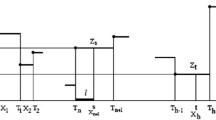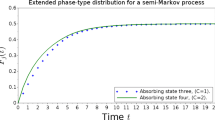Abstract
The credit risk problem is one of the most important issues of modern financial mathematics. Fundamentally it consists in computing the default probability of a company going into debt. The problem can be studied by means of Markov transition models. The generalization of the transition models by means of homogeneous semi-Markov models is presented in this paper. The idea is to consider the credit risk problem as a reliability problem. In a semi-Markov environment it is possible to consider transition probabilities that change as a function of waiting time inside a state. The paper also shows how to apply semi-Markov reliability models in a credit risk environment. In the last section an example of the model is provided.
Mathematics Subject Classification (2000): 60K15, 60K20, 90B25, 91B28
Journal of Economic Literature Classification: G21, G33
Similar content being viewed by others
References
1. Altman, E.I. (1998): The importance and subtlety of credit rating migration. Journal of Banking and Finance 22, 1231–1247
2. Blasi, A., Janssen, J., Manca, R. (2004): Numerical treatment of homogeneous and non-homogeneous semi-Markov reliability models. Communications in Statistics, Theory and Methods 33, 697–714
3. Bluhm, C., Overbeck, L., Wagner, C. (2002): An introduction to credit risk modeling, Chapman & Hall/CRC, Boca Raton, FL
4. Carty, L., Fons, J. (1994): Measuring changes in corporate credit quality. The Journal of Fixed Income 4(1), 27–41
5. Çinlar, E. (1975a): Markov renewal theory: a survey. Management Science 21, 727–752
6. Corradi, G., Janssen, J., Manca, R., (2004): Numerical treatment of homogeneous semi-Markov processes in transient case – a straight forward approach. Methodology and Computing in Applied Probability 6, 233–246
7. Crouhy, M., Galai, D., Mark, R. (2000): A comparative analysis of current credit risk models. Journal of Banking and Finance 24, 59–117
8. De Dominicis, R., Manca, R. (1984): A computational procedure for the asymptotic analysis of homogeneous semi-Markov processes. Statistics and Probability Letters 2, 249–253
9. Duffie, D., Singleton, K.J. (2003): Credit risk. Princeton University Press, Princeton
10. Howard, R. (1971): Dynamic probabilistic systems. I, II. Wiley, New York
11. Hu, Y.-T., Kiesel, R., Perraudin, W. (2002): The estimation of transition matrices for sovereign credit ratings. Journal of Banking and Finance 26, 1383–1406
12. Israel, R.B., Rosenthal, J.S., Wei, J.Z. (2001): Finding generators for Markov chains via empirical transition matrices, with applications to credit ratings. Mathematical Finance 11, 245–265
13. Jarrow, A.J., Lando, D., Turnbull, S.M. (1997): A Markov model for the term structure of credit risk spreads. The Review of Financial Studies 10, 481–523
14. Kavvathas, D. (2001): Estimating credit rating transition probabilities for corporate bonds. Working paper. University of Chicago, Chicago
15. Lando, D., Skodeberg, T.M. (2002): Analyzing rating transitions and rating drift with continuous observations. Journal of Banking and Finance 26, 423–444.
16. Levy, P. (1956): Processus semi-markoviens. In: Proceedings of the International Congress of Mathematics, Amsterdam, 1954. North-Holland, pp. 416–426
17. Limnios, N., Oprişan, G. (2001): Semi-Markov processes and reliability modeling. Birkhäuser Boston, Boston, MA
18. Nickell, P., Perraudin, W., Varotto, S. (2000): Stability of rating transitions. Journal of Banking and Finance 24, 203–227
19. Osaki, S. (1985): Stochastic system reliability modeling. Series in Modern Applied Mathematics, 5. World Scientific, Singapore
20. Pyke, R. (1961): Markov renewal processes with finitely many states. The Annals of Mathematical Statistics 32, 1243–1259
21. Smith, W. L. (1955): Regenerative stochastic processes. Proceedings of the Royal Society. London. Series A 232, 6–31
22. Standard & Poor's creditreview (1993): Corporate default, rating transition study updated. McGraw-Hill, New York
Author information
Authors and Affiliations
Rights and permissions
About this article
Cite this article
D’Amico, G., Janssen, J. & Manca, R. Homogeneous semi-Markov reliability models for credit risk management*. Decisions Econ Finan 28, 79–93 (2006). https://doi.org/10.1007/s10203-005-0055-8
Received:
Accepted:
Issue Date:
DOI: https://doi.org/10.1007/s10203-005-0055-8




